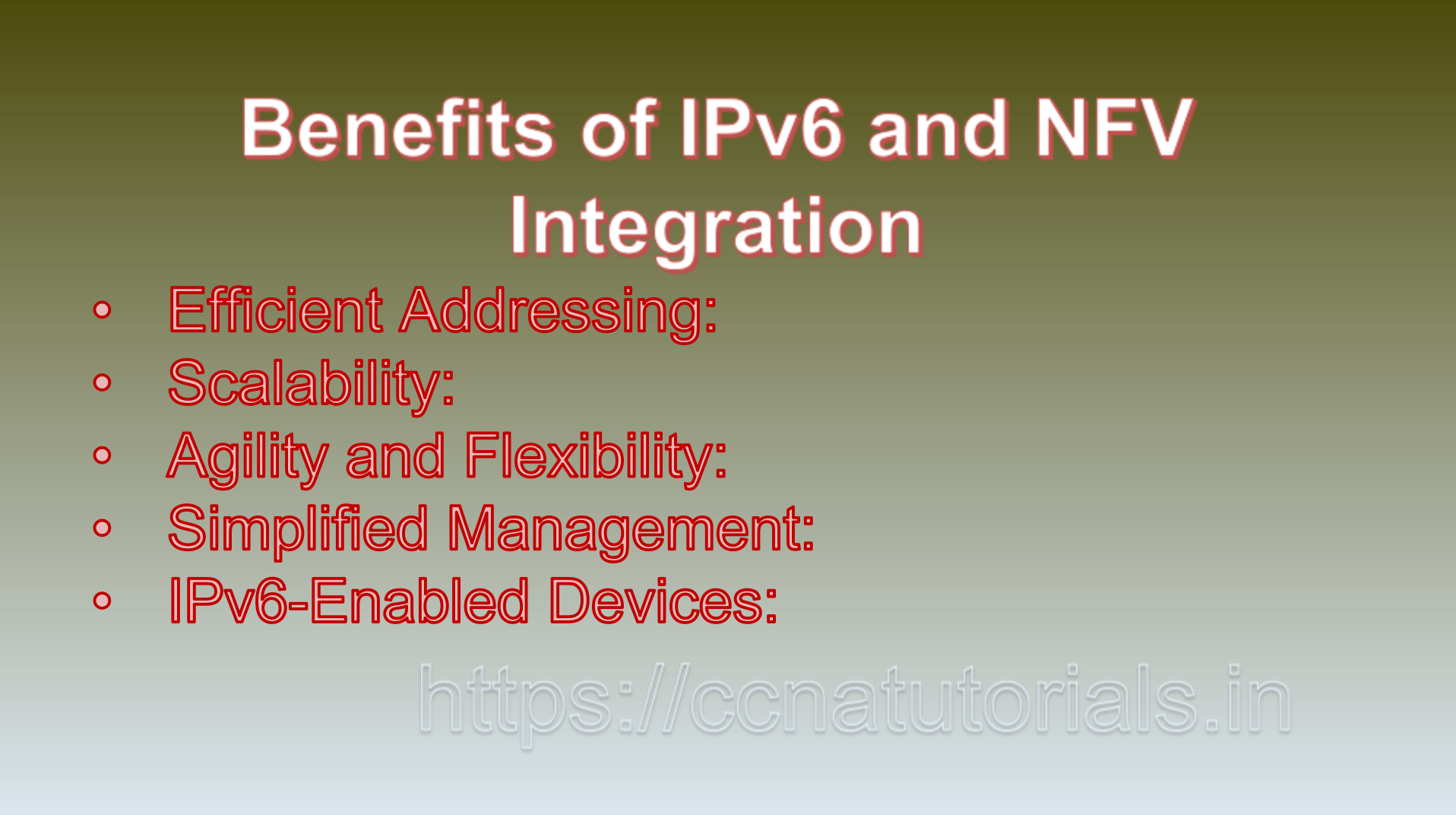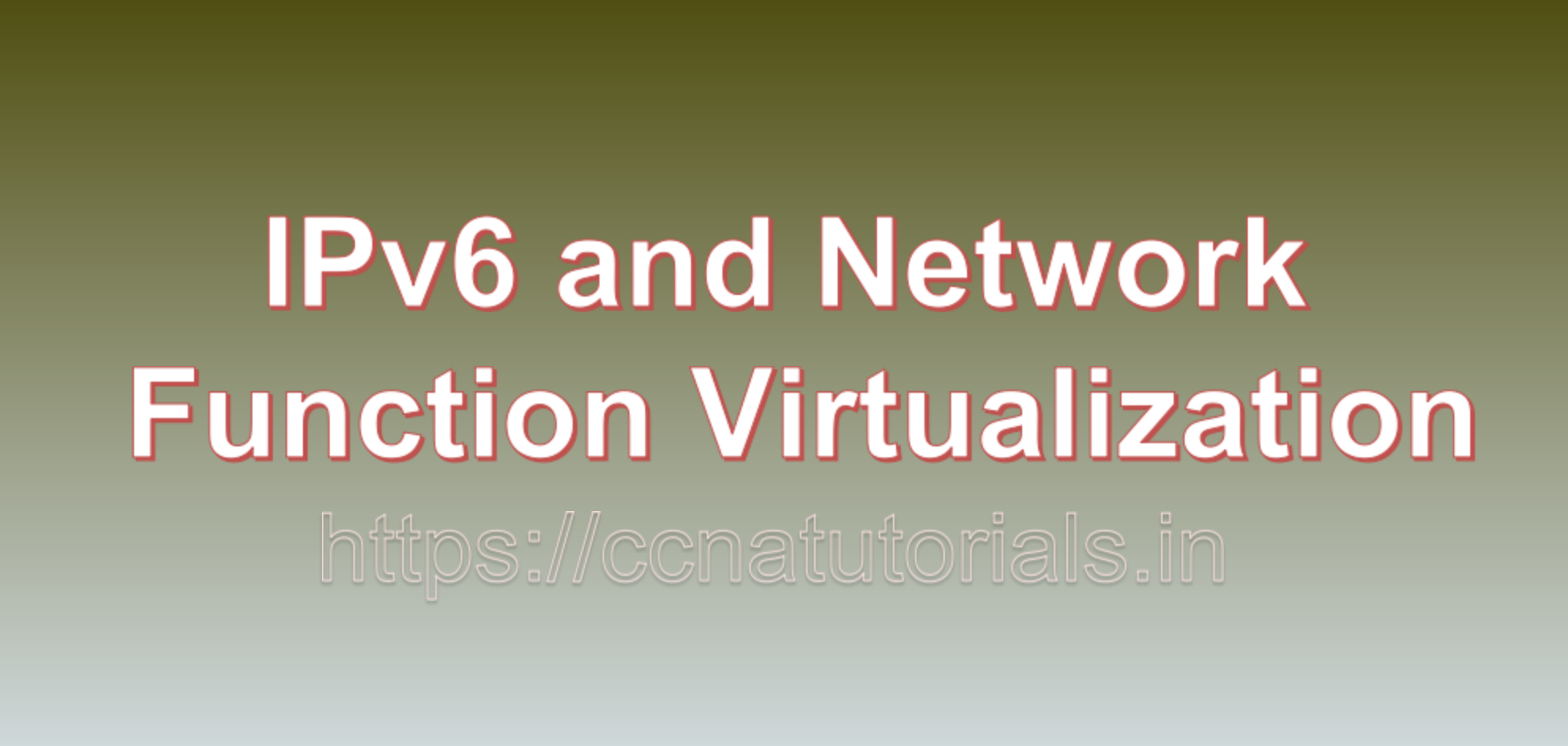Contents of this article
In this article, I describe IPv6 and Network Function Virtualization (NFV): Transforming Network Architecture and Services. The integration of IPv6 (Internet Protocol version 6) with Network Function Virtualization (NFV) marks a significant advancement in the design and operation of modern networks. NFV is a transformative approach that involves virtualizing network functions to decouple them from dedicated hardware, resulting in greater flexibility and scalability. IPv6, with its enhanced address space and improved features, complements NFV by providing efficient addressing, seamless connectivity, and support for the growing number of devices in virtualized networks. In this article, we’ll explore the synergy between IPv6 and NFV, their advantages, implementation considerations, and provide examples to illustrate their importance in modern networking.
Understanding IPv6 and Network Function Virtualization
IPv6: IPv6 is the successor to IPv4, designed to overcome the limitations of its predecessor by offering a significantly larger address space, improved routing efficiency, and advanced features. IPv6 ensures that there are ample unique IP addresses to accommodate the growing number of connected devices.
Network Function Virtualization (NFV): NFV is an architectural concept that involves virtualizing network functions traditionally performed by dedicated hardware appliances. By abstracting network functions into software-based instances, NFV enables greater agility, scalability, and cost savings in network deployment and management.
Benefits of IPv6 and NFV Integration
1. Efficient Addressing:
IPv6’s expansive address space aligns well with the scalability requirements of NFV deployments, including addressing for virtualized network functions and devices.
2. Scalability:
NFV-enabled networks can scale dynamically with IPv6, accommodating the growing number of virtualized network functions and services.
3. Agility and Flexibility:
IPv6 and NFV together allow for the rapid deployment, relocation, and scaling of virtualized network functions, adapting to changing network demands.
4. Simplified Management:
IPv6 enhances NFV’s ability to centrally manage and configure virtualized network functions, leading to efficient control and monitoring.
5. IPv6-Enabled Devices:
As more devices adopt IPv6, NFV can efficiently manage network functions for a diverse range of devices without the need for address translation.
IPv6 and NFV Implementation Considerations
1. IPv6 Network Infrastructure:
Organizations implementing NFV need to ensure that their network infrastructure supports IPv6 to fully leverage its capabilities.
2. Virtual Network Function (VNF) Compatibility:
VNFs must be IPv6-compatible to ensure seamless operation in virtualized environments.
3. Security Measures:
As virtualized network functions become critical components, robust security measures must be implemented to protect NFV-enabled networks.
Examples Illustrating IPv6 and NFV Integration
1. Virtualized Firewall and Security Services:
In a network environment, imagine deploying virtualized firewalls and security services using NFV. By integrating IPv6:
– IPv6 addresses are assigned to virtualized security functions, ensuring efficient communication and protection for IPv6-enabled devices.
– Scalability is supported as more virtualized security instances are deployed to handle increasing traffic demands.
– The combination of IPv6 and NFV enables agile security policy updates and efficient handling of network threats.
2. Virtual Private Networks (VPNs):
Consider a scenario where virtualized VPNs are deployed using NFV to provide secure remote access for employees. With IPv6 integration:
– IPv6 addresses facilitate efficient communication between remote devices and virtualized VPN gateways.
– NFV allows the scaling of VPN instances to accommodate a growing number of remote users, while IPv6 addresses handle the addressing needs.
– IPv6’s compatibility with modern devices ensures seamless remote access for various devices with native IPv6 support.
3. Content Delivery and Caching:
In a content delivery network (CDN), NFV used to deploy virtualized caching services. By integrating IPv6:
– IPv6 addresses are assigned to virtualized caching instances, supporting efficient content delivery to IPv6-enabled devices.
– NFV enables the dynamic allocation of caching resources based on demand, enhancing content delivery efficiency.
– The combination of IPv6 and NFV supports the scaling of caching services across a distributed network infrastructure.
Short description of IPv6 and Network Function Virtualization
The integration of IPv6 with Network Function Virtualization (NFV) presents a transformative approach to network design, operation, and management. IPv6’s expansive address space, efficient routing, and compatibility with modern devices align well with NFV’s goals of flexibility, scalability, and cost-effectiveness. From virtualized security services to VPNs and content delivery, the synergy between IPv6 and NFV empowers organizations to build and manage dynamic networks that can adapt to changing demands while efficiently serving a growing number of devices. As networks continue to evolve, the integration of IPv6 and NFV will play a crucial role in shaping the future of networking architectures and services.

IPv6 and Network Function Virtualization (NFV): Transforming Network Infrastructure and Services
The integration of IPv6 (Internet Protocol version 6) with Network Function Virtualization (NFV) marks a significant evolution in network architecture and service delivery. NFV involves abstracting and virtualizing network functions, such as firewalls, routers, and load balancers, to run as software instances on general-purpose hardware. IPv6 complements NFV by providing a larger address space, efficient routing, and enhanced scalability, thereby enhancing the capabilities of virtualized network functions. In this article, we’ll explore the synergy between IPv6 and NFV, their benefits, implementation considerations, and provide examples to illustrate their importance in modern networking.
Understanding IPv6 and Network Function Virtualization: An Overview
IPv6: IPv6 is the successor to IPv4, designed to address the limitations of its predecessor by offering an immensely larger address space, improved routing efficiency, and advanced features. IPv6 ensures that there are ample unique IP addresses to accommodate the growing number of connected devices.
Network Function Virtualization (NFV): NFV involves the decoupling of network functions from dedicated hardware appliances and encapsulating them in software-based instances that can run on standard servers. This enables flexibility, scalability, and efficient resource utilization in network services.
Benefits of IPv6 and NFV Integration
1. Efficient Addressing:
IPv6’s expansive address space supports the addressing needs of the numerous virtualized network functions, allowing each function to have its own unique IP address.
2. Scalability:
NFV-enabled networks can scale effectively with IPv6, accommodating the deployment of additional virtualized functions without running out of available addresses.
3. Dynamic Routing:
IPv6’s improved routing capabilities enhance NFV’s dynamic routing algorithms, optimizing the flow of traffic between virtualized functions.
4. Service Agility:
NFV allows for rapid deployment and provisioning of virtualized network functions, and IPv6’s compatibility ensures smooth connectivity for these functions.
5. IoT Integration:
IPv6’s support for the Internet of Things (IoT) aligns with NFV’s adaptability to accommodate IoT-related network functions and devices.
IPv6 and NFV Implementation Considerations
1. Infrastructure Compatibility:
Organizations implementing NFV need to ensure that their network infrastructure and NFV platforms support IPv6 to maximize the benefits of both technologies.
2. Address Management:
IPv6 address management in NFV environments must be well-organized to prevent address conflicts and efficiently allocate addresses to virtualized functions.
3. Security and Segmentation:
Security measures need to be implemented to protect virtualized network functions, especially given their potential exposure to the broader internet via IPv6 addresses.
Examples Illustrating IPv6 and NFV Integration
1. Virtualized Firewall:
Consider a network with a virtualized firewall deployed as part of an NFV architecture. By integrating IPv6 with NFV:
– The virtualized firewall can have a unique IPv6 address, allowing for efficient routing and communication.
– IPv6’s scalability ensures that additional instances of virtualized firewalls can be deployed to handle increased traffic and security requirements.
– As the network incorporates IPv6-enabled devices, the virtualized firewall efficiently filters and manages traffic based on IPv6 addresses.
2. Virtualized Load Balancer:
In an NFV environment, a virtualized load balancer distributes incoming traffic across multiple servers. With IPv6 integration:
– IPv6 addresses are assigned to each instance of the virtualized load balancer, ensuring effective routing of IPv6 traffic to appropriate servers.
– As the network’s IPv6 traffic grows, additional virtualized load balancers can be deployed to handle the increased load.
– Scalability is achieved while maintaining efficient traffic distribution for IPv6-enabled services.
Conclusion IPv6 and Network Function Virtualization
The integration of IPv6 with Network Function Virtualization (NFV) represents a powerful combination that transforms network infrastructure and service delivery. IPv6’s expansive address space, efficient routing, and compatibility with IoT devices complement the flexibility and scalability of NFV. By enabling virtualized network functions to communicate seamlessly over IPv6, organizations can achieve enhanced network agility, improved resource utilization, and optimized service delivery. As the demand for dynamic and adaptable network services continues to grow, the synergy between IPv6 and NFV will play a crucial role in shaping the future of networking architecture and capabilities.






